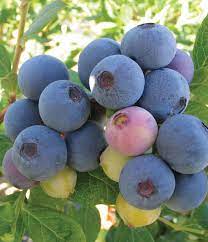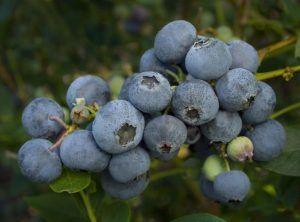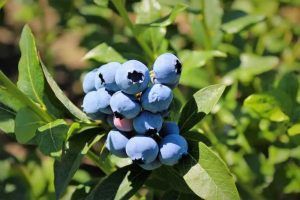Blueberries are a delicious and healthy addition to any garden, and they can easily be grown in the state of Florida. If you’re considering planting blueberries in your Florida garden, here are a few tips to help you get started growing Southern Highbush Blueberries.
Southern highbush blueberries combine the fruit quality and productivity of highbush blueberries with the low chilling requirement necessary to produce a crop in the Florida climate. Beginning in the early to mid-1990s, most new blueberry plantings in Florida consisted of southern highbush. Currently, with the exception of small U-pick farms, Florida’s blueberry acreage consists almost entirely of southern highbush varieties, mostly developed by the University of Florida’s blueberry breeding program.
Springhigh Variety…

‘Springhigh’ was released by the University of Florida in 2004. It is a vigorous, upright cultivar that has exceptionally good survival in the field. ‘Springhigh’ appears to be adapted to north-central and central Florida. ‘Springhigh’ ripens about 5–10 days earlier than the standard mid-season cultivars (‘Star’, ‘Windsor’, ‘Emerald’, and ‘Jewel’). The berries are very large and have good to excellent flavor. Berries of ‘Springhigh’ have less waxy bloom on their surfaces, making them darker than most other cultivars. They have only medium-good scars with a tendency for some tearing of the berry skin around the picking scar during harvest. Also, they have only medium firmness, which sometimes presents problems during commercial packing and shipping, but should not be an issue for home gardeners. The berries are very attractive to flower thrips, which in many years are abundant during the weeks when ‘Springhigh’ is ripening. If thrips populations are not kept very low when ‘Springhigh’ is beginning to ripen, their damage will soften the berries and reduce berry postharvest storage life.
![]()
Farthing Variety…

‘Farthing’ was released by the University of Florida in 2007. It is a vigorous plant with a dense, compact canopy. The leaves tend to be healthy and relatively free of leaf spot diseases. The berries are large and firm, and they have a good picking scar but tend to be dark in color because of low surface wax content. ‘Farthing’ produces numerous flower buds, and dormant pruning may be required to prevent over-fruiting. ‘Farthing’ flowers later than most Florida cultivars, but before ‘Star’ or ‘Windsor’. The berries on ‘Farthing’ generally ripen at about the same time as ‘Star’, but it produces significantly higher yields than ‘Star’. ‘Farthing’ has performed well in north-central Florida, but it is a new cultivar and its adaptive range has not been fully determined.
![]()
Blue Crisp Variety…

The Bluecrisp Blueberry is a new and distinct variety of blueberry is a low-chill, tetraploid high bush blueberry (Vaccinium) that has a unique combination of features. It was developed by the University of Florida’s blueberry breeding program and has a complex ancestry, with genes from both V. corymbosum L. and V. Darrow Camp. The plant is vigorous and semi-upright with a low chill requirement, meaning it will flower and leaf in areas where the mean temperature of the coldest month is 58° F or colder.
The fruit produced by the Bluecrisp plant is large, firm, and has a good picking scar and flavor. It also has a distinctly crisp texture when chilled to 50° F. The fruit ripens 60 days after flowering and 80% of it will be ready between April 20 and May 15. The Bluecrisp plant is also resistant to Phytophthora root rot and Botryosphaeria stem blight, two common diseases in highbush blueberries.
The Bluecrisp blueberry plant can be easily propagated by softwood cuttings. It is a great option for blueberry growers looking for a plant with high yields and high-quality fruit.
![]()
Blueberry Culture…
First, choose the right location for your blueberry bushes. Blueberries prefer well-draining, acidic soil with a pH between 4.5 and 5.5. If your soil is not naturally acidic, you can add sulfur or other acidic amendments to lower the pH. Blueberries also need full sun, so make sure to choose a spot that gets at least six hours of direct sunlight per day.
Planting your Blueberries…
Once you have chosen the right location and varieties, it’s time to plant your blueberry bushes. Blueberries are best planted in the fall or early winter when the weather is cooler and the soil is moister. Dig a hole that is slightly larger than the root ball of your blueberry bush and mix in some compost or well-rotted manure to give your plant a good start. Water your blueberry bush well after planting, and be sure to mulch around the base to help retain moisture and suppress weeds.
Height…
The highbush blueberry (Vaccinium corymbosum) is a native 6 to 12 feet tall, upright, crown-forming, North American shrub. It is commonly referred to as the northern and southern highbush. The highbush is the major blueberry plant of commerce with more than 50 cultivars (or cultivated varieties) developed
Perform best with soils that have 2–3% organic matter
The best time to plant blueberries is from mid-December to mid-February
Peat moss or pine bark is commonly used to increase soil organic matter in blueberry plantings. Peat moss can be incorporated into the soil at or prior to planting. Pine bark can also be mixed into the soil
Blueberries require a soil pH of 4.0–5.5
Blueberries require a well-drained soil profile of at least 18 inches in depth. Blueberries require regular watering, especially during dry spells. Aim to keep the soil evenly moist, but be careful not to overwater, as this can lead to root rot. Fertilize your blueberry bushes in the spring with an acidic fertilizer, and prune them annually to remove any dead or diseased branches.
Set plants in a sunny area (at least 4–5 hours of full sun per day) away from the roots of trees except for pines and at least 20 feet away from any building foundation
During the first growing season, remove all the flowers before they turn into fruit to firmly establish your plants and make the crop stronger the following year. Remember, you’ll need at least two different varieties planted close together for cross-pollination.
With proper care, your blueberry bushes should start producing fruit in their second or third year. You can harvest blueberries from late spring through early fall, depending on the variety and your location in Florida. Enjoy your homegrown blueberries fresh, or use them in pies, jams, or other recipes.
Growing blueberries in Florida is a rewarding and delicious hobby. With the right location, varieties, and care, you can enjoy these tasty fruits in your own backyard
![]()


